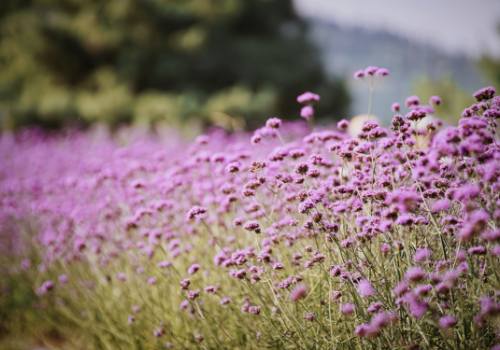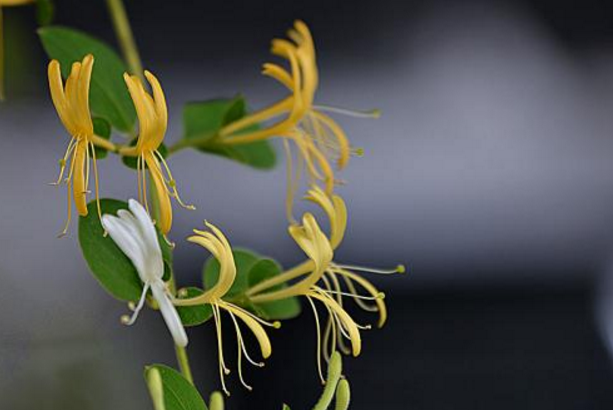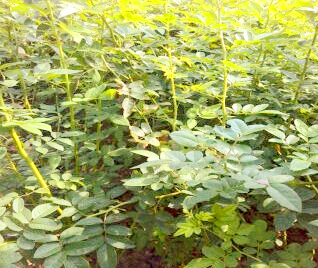How much is the price of lavender seeds in 2019? What are the prospects for growing lavender?
Lavender, also known as spirit vanilla and yellow vanilla, is known as the "king of spices" in nature. It has high medicinal value, beautiful and elegant flower shape and high ornamental value. So, what is the price of lavender seeds in 2019? What are the prospects for growing lavender?

Price of lavender seeds
There are many varieties of lavender, so the prices of different kinds of seeds are also different. some cheap lavender seeds cost 300 to 400 yuan per jin, expensive ones cost thousands of yuan per jin, and even some rare varieties and good quality can sell for tens of thousands of yuan per catty. In addition, the price of lavender seeds is also affected by the fluctuation of lavender output in that year, with different seed batches, different specifications, and different prices from different places.
Second, the planting prospect of lavender
Lavender is not only a valuable spice crop, but also a valuable ornamental plant. The essential oil produced by lavender is of high quality and long-lasting fragrance. It is very popular in the international spice market. Its skin care products and cosmetics sell well at home and abroad. There is a lot of room for development in the fields of family health care, medicine, food processing, aromatherapy handicrafts and so on. It can be said that the economic benefits of planting lavender are very rich. There is a wide market, and it is the only choice to get rich.
Cost and profit of planting lavender
The cost of planting lavender is about 5000 yuan per mu. Generally speaking, the profit of planting lavender is between 30% and 40%. In some places, the lower cost of water, electricity and labor may lead to higher profit margins, so this profit is a variable.
Fourth, the planting value of lavender
Lavender has a wide variety of plants, with high ecological ornamental value, its plants are low, the whole plant is gray-purple in four seasons, strong vitality, resistance to pruning, beautiful leaf shape, noble and elegant, can be used to build lavender special aromatic botanical garden. to achieve greening, beautification, make-up, fragrance integrated, not only can watch, but also can purify the air, treat diseases, play the role of medical and health care.
Fifth, the efficacy and function of lavender
1. Lavender can maintain and treat the body, relax the body and mind, calm and calm the mind, and put a little around can relieve the body and mind.
2. Lavender also has an effect on nerves, soothing emotions, purifying the mind, reducing feelings of anger and exhaustion, and balancing the central nervous system.
3. Lavender can also improve insomnia, reduce high blood pressure, calm the heart, help improve respiratory, gynecological and digestive system problems, kill insects and purify the air. Lavender is good for calming nerves and improving sleep fatigue.
4. Lavender is also good for the skin, promoting cell regeneration, balancing oil secretion, improving the skin of scald, sunburn, eczema, psoriasis and abscess, improving scars, inhibiting bacterial growth, and helping hair growth. Lavender can promote cell regeneration and balance oil.
How to plant lavender seeds for daily maintenance
Lavender has been a common vanilla since Roman times. Because of its many effects, it is called vanilla queen. The hedge formed by the blue flowers of lavender is even more refreshing. This problem is no longer a big deal for flower growers, but many friends who are not clear about planting have a lot of doubts. Growing flowers is not so easy and requires skill and patience. Patience can be cultivated by everyone. Let's talk about lavender seed planting.
First, about lavender seeds
Lavender seeds are relatively small, and the budding rate is low, so the general sowing soil needs to be loose, breathable, high water holding capacity, and fully sterilized. Can use vermiculite, peat, water moss, perlite, serpent sawdust and other mixed soil. You can configure it yourself if you have the conditions. Lavender seeds can be replaced by smaller flowerpots or other containers. For example, a yogurt box uses an awl to pierce several small holes in the bottom of the box. Disposable plastic cups are also available, but because they are transparent, it is best to paste them with black paper or cover them with a paper cup.
After the lavender seeds germinate, the seedlings grow 4 or 6 true leaves and can be put on the pot. You need to use a small basin at the beginning. Wait for the seedling to grow up, and then replace the big basin as appropriate. When changing the basin, wait until the soil is dry (because it should be watered after changing the basin, if the soil is wet, the wet time is too long, and the seedlings are easy to grow poorly). First, add more than half of the fertile soil to the small basin. In order not to destroy the root system, there is no need to shake off the soil near the root when transplanting. Move it directly into a small basin and fill the soil with the roots. Be sure to water thoroughly and shade for a few days after transplantation. And then you can put it in the sun for maintenance.
Women have a natural love for lavender, lavender has a strong ornamental, but also has the effect of repelling mosquitoes. Therefore, many families will buy lavender seeds to grow their own, but the survival rate of lavender seeds is so low, so we need to know how to grow lavender seeds.
II. Planting methods of lavender seeds
1. Soil: lavender seeds are suitable for slightly alkaline or neutral sandy soil. Good drainage requirements can be used after mixing perlite, vermiculite and peat moss. If you want to pay attention to the drainage of the soil when cultivating in the open field, you can pile the soil high and then plant it.
2. Watering: lavender does not like the retention of water in the roots. After one-time watering, the soil should be fed again when the soil is dry. The surface culture medium is dry, the interior is moist, and the leaves wilt slightly. Watering should be kept away from the sun, usually in the morning, water should not be splashed on leaves and flowers, otherwise it is perishable and breeds diseases and insect pests. A persistent humid environment can lead to poor growth of the roots without enough air to breathe, or even sudden death of the whole plant, which is often the reason for the failure of lavender cultivation.
3. Lighting: lavender is an all-day plant, which needs sufficient sunlight and humid environment. The environment that can give full sunshine is better, and half-day sunshine can also grow. Summer should cover at least 50% of the sun and increase ventilation to lower the ambient temperature, so that although the growth is weak, it does not die. In winter, lavender can grow well on flat land and should be cultivated under full-day sunshine.
4. Temperature: lavender likes to be warm in winter and cool in summer, the optimum growth temperature is 15: 25 ℃, and can grow at 5: 30 ℃. The top stems and leaves were withered and yellow when they were higher than 38-40 ℃ for a long time. The dormancy begins when the temperature is too low below 0 ℃, and the seedlings can withstand the low temperature of ~ 20 ~ 25 ℃ during dormancy.
5, fertilization: fertilizing can put bone meal in the basin soil as base fertilizer, usually once a quarter, seedlings can apply Huabao 2 (20-20-20), and then apply fertilizer with higher phosphate fertilizer such as Huabao-3 (20-30-20). Apply light fertilizer.
6. Pruning: lavender flowers are the most abundant in essential oil, and flowers or inflorescences are mainly used. In order to facilitate harvest, some small inflorescences at the initial stage of cultivation might as well be completely trimmed with large scissors, and the newly grown inflorescences are highly consistent, which is beneficial to a harvest. Some varieties can reach a height of up to 90 centimeters, and this method is also used to make the plants low and make them more branched, blossom and increase the yield.
Daily maintenance of lavender seeds
Lavender can't stand the heat and humidity, and it will die if it suffers from waterlogging for a long time. When planting outdoors, be careful not to let Rain Water sprinkle directly on the plant. After May, you need to move places where there is no direct sunlight, increase ventilation to lower the ambient temperature and keep cool, so that you can safely get through the hot summer. Lavender doesn't like the retention of water in the roots. After one-time watering, the soil should be fed again when the soil is dry. The surface culture medium is dry, the interior is moist, and the leaves wilt slightly. Water in the morning, avoid the sun, do not splash water on leaves and flowers, otherwise it is perishable and breeds diseases and insect pests. A persistent humid environment can lead to poor growth of the roots without enough air to breathe, or even sudden death of the whole plant, which is often the reason for the failure of lavender cultivation.
Lavender is an all-day plant, which needs plenty of sunlight and humid environment. The environment that can give full sunshine is better. Half-day sunshine can also grow, but flowering is rare. Summer should cover at least 50% of the sun and increase ventilation to lower the ambient temperature, so that although the growth is weak, it does not die. Lavender can grow well on flat land in winter and should be cultivated under full-day sunshine.
Lavender is semi-heat-resistant, cool, warm in winter and cool in summer. The suitable temperature for growth is 15: 25 ℃. It can grow at 5: 30 ℃. The limiting temperature is above 35 ℃, which is higher than 38-40 ℃ for a long time. The top stem and leaf are withered and yellow. In northern China, dormancy begins when it is below 0 ℃ for a long time in winter, and the seedlings can tolerate a low temperature of 20 ℃ at dormancy.
Lavender seed
Finally, the relevant information about lavender seeds is introduced here. I hope this article will be helpful to you. If there is anything else you don't understand, you can leave a message below, and we will answer it for you as soon as possible.
Lavender seed how to plant lavender seed price
Lavender has always been a favorite flower plant, the whole plant has a fragrant smell, leaf-shaped flowers beautiful and elegant, blue-purple inflorescences long and beautiful, suitable for flower path cluster planting or strip planting, can also be potted ornamental, but also has a good mosquito repellent effect. Many families grow lavender will choose seed sowing method, it is not easy to cultivate plant seeds, especially the survival rate of lavender seeds is still relatively low, then how to plant lavender seeds? What are the planting methods and techniques of lavender seeds? Let's learn about this:
Lavender seed price:
We naturally have to buy lavender seeds before planting. What we want to know is the price of lavender seeds. The price of lavender seeds is very different from the varieties of lavender. Now the lavender seeds bought online are generally calculated by grains, 20 to 30 seeds cost about 5 yuan, and the prices sold in different regions are not the same.
Lavender seed planting method:
1. Container
Families sowing lavender seeds can use smaller flowerpots or other containers instead. For example, a yogurt box uses an awl to pierce several small holes in the bottom of the box. Disposable plastic cups are also available, but because they are transparent, it is best to paste them with black paper or cover them with a paper cup (the roots of plants can affect growth if exposed to sunlight, and the soil tends to grow green moss).
2. Plant materials
Lavender seeds are relatively small, and the budding rate is low, so the general sowing soil needs to be loose, breathable, high water holding capacity, and fully sterilized. Can use vermiculite, peat, water moss, perlite, serpent sawdust and other mixed soil. You can configure it yourself if you have the conditions.
3. Soak in warm water
The seeds of lavender should be soaked in 40 degrees warm water. Soak for 24 hours after the water is cool. It's easy to sprout.
4. Sowing method
Generally speaking, for larger seeds (such as lavender and sage), you can order 2-3 seeds in each container. Leave a stronger one after germination depending on the growth of the seedlings. Small seeds (such as Mayoram) can be sown. Touch some seeds with your hands and sprinkle them gently on the soil. The seedlings sprouted after germination. Leave 1-3 seedlings as appropriate.
5. Cover the soil
The thickness of seed cover depends on the size of the seed. It is generally 2-3 times the diameter of the seed. The soil of small seeds should be thinner, and lavender seeds can be thicker. Some seeds have strong phototaxis and can not be covered with soil (such as vanilla, Rosemary).
6. Moisturizing
Water thoroughly after sowing. A fine spray can is used for watering. Don't push hard so as not to wash the seeds away. It is best to use the sitting basin method, that is, use a large basin to hold 3 basins of water, and sit the container in the basin. Let the water seep in through the bottom hole of the container. The water level in the large basin should not exceed the height of the soil in the container.) After sowing, the container should be covered with plastic film, and there are several small holes in the plastic film to breathe. Put the container in the sun and keep the temperature about 20 degrees. Most seeds can germinate after a week.
Management of lavender seeds after germination:
After the lavender seeds germinate, you can take off the cling film. If the seed is small, you can take it off until the seedling is a little stronger.
Lavender transplant into the basin:
After the lavender seeds germinate, the seedlings grow 4 or 6 true leaves and can be put on the pot. You need to use a small basin at the beginning. Wait for the seedling to grow up, and then replace the big basin as appropriate. When changing the basin, wait until the soil is dry (because it should be watered after changing the basin, if the soil is wet, the wet time is too long, and the seedlings are easy to grow poorly). First, add more than half of the fertile soil to the small basin. In order not to destroy the root system, there is no need to shake off the soil near the root when transplanting. Move it directly into a small basin and fill the soil with the roots. Be sure to water thoroughly and shade for a few days after transplantation. And then you can put it in the sun for maintenance.
The above is the editor to share with you how to plant lavender seeds, the cultivation of lavender seeds need to master certain techniques, watering at an appropriate time, etc., to provide the most suitable maintenance environment, so that lavender seeds can germinate and grow smoothly.
- Prev

How much is the price of honeysuckle per jin in 2019? High-yield planting techniques of honeysuckle trees in four seasons are attached!
Honeysuckle is a common traditional Chinese medicine in daily life, which is usually used to make tea and has the effect of clearing away heat and detoxification. it can treat influenza, tonsillitis and other diseases, so how much is the price of honeysuckle in 2019? High-yield planting techniques of honeysuckle trees in four seasons are attached! Price of honeysuckle in 2019
- Next

Introduction to the planting method of rose "one of the world's famous ornamental plants"!
Rose is one of the world-famous ornamental plants, which has a long history of cultivation in China. Because of its fragrance and high ornamental value, it is liked by many people, and many people want to plant it. Then the editor will introduce the planting method of rose: sowing, sowing is usually carried out after autumn or spring sowing after sand storage.
Related
- Fuxing push coffee new agricultural production and marketing class: lack of small-scale processing plants
- Jujube rice field leisure farm deep ploughing Yilan for five years to create a space for organic food and play
- Nongyu Farm-A trial of organic papaya for brave women with advanced technology
- Four points for attention in the prevention and control of diseases and insect pests of edible fungi
- How to add nutrient solution to Edible Fungi
- Is there any good way to control edible fungus mites?
- Open Inoculation Technology of Edible Fungi
- Is there any clever way to use fertilizer for edible fungus in winter?
- What agents are used to kill the pathogens of edible fungi in the mushroom shed?
- Rapid drying of Edible Fungi

